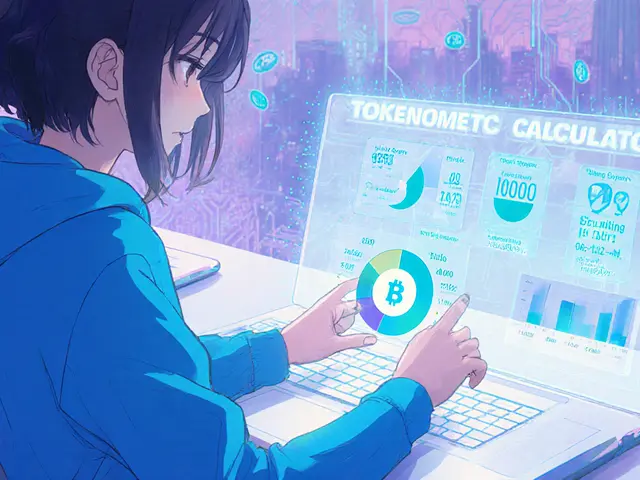YuzuSwap Tokenomics Calculator
Total Supply
500,000,000 YUZU
Circulating Supply
393,300,000 YUZU
Remaining Supply
59,500,000 YUZU
Annual Halving Rate
50% every year
Liquidity Mining
70%
Team
10%
Foundation
10%
Investors
10%
Simulate how much YUZU you could earn through trade mining.
Estimated Rewards:
Project token supply over time with annual halvings.
Supply Projection:
YuzuSwap is a decentralized exchange (DEX) built on the Oasis Emerald paratime blockchain. It promises low‑cost swaps, privacy‑focused smart contracts, and a novel trade‑mining incentive system. This review breaks down how the platform works, its token economics, security posture, and where it stands against the big DEX players.
TL;DR
- YuzuSwap runs on Oasis, offering privacy‑preserving swaps with sub‑$0.01 fees.
- The native YUZU token fuels governance, liquidity mining and trade mining.
- Trade mining lets you earn forever from a single trade via Trading Pool Share Tokens (TPST).
- Liquidity is modest - daily volume under $20k - so expect slippage on larger orders.
- Best for Oasis enthusiasts; not yet a competitor to Uniswap or SushiSwap.
How YuzuSwap Works - The Core Mechanics
At its heart, YuzuSwap follows the automated market maker (AMM) model: you deposit token pairs into a liquidity pool, and the smart contract calculates prices using the constant‑product formula (x·y = k). What sets it apart is the trade mining layer. When you swap a supported pair, the protocol automatically mints TPST to your address. These tokens represent your trading contribution and keep mining rewards block after block until you claim them, at which point the TPST balance resets.
This "trade once, mine forever" approach encourages frequent trading while rewarding long‑term holders. The rewards are paid in YUZU and are proportional to your TPST share of the total pool.
Tokenomics - Supply, Distribution, and Deflation
The YUZU token has a capped supply of 500million, with 452.8million minted so far. Around 393.3million are circulating, leaving roughly 59.5million still to be mined. Tokens are released block by block from a fair launch - there was no pre‑mining, and the team’s allocation (10%) comes from the same schedule.
Key allocation breakdown:
- 70% for liquidity mining and trade mining pools
- 10% team
- 10% foundation
- 10% early investors
Every year the amount minted per block halves, mirroring Bitcoin’s halving cycle. This built‑in scarcity should, in theory, help price appreciation if demand grows.
Security and Governance - Who Controls YuzuSwap?
YuzuSwap is non‑custodial. Users keep their private keys, meaning the platform can’t seize funds. Governance is handled by the Yuzu DAO, which uses YUZU voting power to decide on fee structures, new pair listings, and protocol upgrades. Activity logs on the Oasis explorer show periodic proposals, but participation rates are relatively low compared with larger ecosystems.
Smart‑contract audits have been performed by an independent firm (the report is publicly available on the project’s GitHub). No critical vulnerabilities have been discovered to date, though the platform’s limited exposure means fewer eyes are on the code than on Ethereum‑based DEXs.

Liquidity, Trading Volume, and Market Presence
Liquidity remains the biggest hurdle. BeatMarket reports an average daily volume of about $15,800, which is a fraction of the millions seen on Uniswap. Price feeds differ across trackers: LiveCoinWatch lists a daily high of $0.002012, while Crypto.com shows $0.0004006. The discrepancy reflects thin order books and fragmented trading across a handful of niche aggregators.
Because YUZU isn’t listed on major centralized exchanges, exit liquidity depends on the DEX itself. Large swaps can suffer 5‑10% slippage, making the platform best suited for modest trades or for users who already hold YUZU.
YuzuSwap vs. Major DEXs - A Quick Comparison
| Feature | YuzuSwap | Uniswap (Ethereum) | SushiSwap (Multi‑chain) |
|---|---|---|---|
| Underlying blockchain | Oasis Emerald paratime | Ethereum | Ethereum, BSC, Polygon, etc. |
| Typical fee | ≈0.5% | 0.30% | 0.25% |
| Native token | YUZU (governance & mining) | UNI | SUSHI |
| Liquidity incentives | Liquidity + Trade mining | Liquidity mining only | Liquidity + Yield farming |
| Daily volume (approx.) | $15k‑$20k | >$1‑2B | >$300‑500M |
| Privacy focus | Yes (Oasis confidential contracts) | No | No |
For users who value privacy and already operate on Oasis, YuzuSwap’s unique trade‑mining model can be attractive. For anyone chasing deep liquidity or a broad token list, the Ethereum‑based DEXs remain the better choice.
Step‑by‑Step: Using YuzuSwap
- Set up a Web3 wallet that supports Oasis (e.g., MetaMask with custom RPC or the Oasis Wallet).
- Connect the wallet to the YuzuSwap UI at
app.yuzuswap.io. - Select a trading pair (most pairs involve YUZU and an Oasis‑native token).
- Enter the amount you want to swap and confirm the transaction. The contract will automatically mint TPST to your address.
- To claim trade‑mining rewards, navigate to the “Rewards” tab, click “Claim”. Your TPST balance resets after the claim.
- If you wish to provide liquidity, click “Add Liquidity”, deposit equal values of the two tokens, and receive LP tokens that also earn liquidity mining rewards.
All actions are on‑chain; there’s no custodial middle‑man. Gas fees on Oasis are generally under $0.001, making frequent small trades viable.
Risks and Red Flags
Every DeFi project carries risk, and YuzuSwap has a few noteworthy ones:
- Low liquidity: Thin order books can cause high slippage and price impact.
- Limited market exposure: YUZU isn’t listed on centralized exchanges, so exiting positions requires using the DEX itself.
- Oasis dependency: Any technical or regulatory issue affecting the Oasis network directly impacts YuzuSwap’s operation.
- Governance participation: The DAO’s low voter turnout may mean future changes are decided by a small core group.
Potential investors should treat YUZU as a high‑risk, high‑potential token, similar to other niche DeFi projects.
Future Outlook - What Could Change?
If the Oasis ecosystem gains traction-especially in privacy‑focused applications-YuzuSwap could see a surge in token demand and liquidity. Upcoming roadmap items include cross‑paratime bridges to enable swaps between Oasis and Ethereum, and the launch of a DAO‑driven insurance fund to protect liquidity providers.
However, without broader exchange listings or a significant user migration, the platform may stay a specialized niche tool.

Frequently Asked Questions
Is YuzuSwap safe to use?
Safety depends on three factors: the smart‑contract code, the underlying blockchain, and user practices. YuzuSwap’s contracts have passed an external audit, and Oasis offers fast, low‑cost transactions. As a non‑custodial DEX, you keep your private keys, which eliminates custodial risk. Nonetheless, low liquidity can cause slippage, and the platform’s niche status means fewer eyes on potential bugs. Use only funds you’re willing to risk.
How does trade mining differ from traditional liquidity mining?
Liquidity mining rewards users for supplying token pairs to a pool. Trade mining, unique to YuzuSwap, rewards the act of swapping itself. When you execute a trade, the protocol mints TPST, which continues to earn YUZU rewards each block until you claim them. This creates a “trade once, mine forever” loop, encouraging active trading rather than just passive liquidity provision.
Can I use MetaMask with YuzuSwap?
Yes. Add the Oasis Emerald RPC (e.g., https://emerald.oasis.io) to MetaMask, then switch the network and connect the wallet on the YuzuSwap interface. The same steps work with the official Oasis Wallet app.
Where can I trade YUZU outside of YuzuSwap?
Currently YUZU is not listed on major centralized exchanges like Crypto.com or Binance. Some niche aggregators show price data, but most actual trading happens on YuzuSwap itself. Watch for future listings if the project launches a bridge to Ethereum or other chains.
What is the annual token‑supply halving and why does it matter?
YuzuSwap reduces the amount of YUZU minted per block by 50% each year. This mirrors Bitcoin’s halving mechanism and creates scarcity over time. If demand for YUZU grows as the Oasis ecosystem expands, the decreasing supply could push the price upward, assuming other factors stay constant.







Comments
Lindsay Miller
June 12, 2025 AT 17:20 PMI get why the low liquidity can feel scary, especially if you're new to DeFi. The trade‑mining idea is clever, but you really should only put in what you can afford to lose. The Oasis network’s cheap fees do help make small trades possible, which eases the pressure a bit. If you keep an eye on slippage and maybe start with a tiny amount, you can test the waters without big risk.
Jacob Anderson
June 17, 2025 AT 08:27 AMOh great, another “innovative” DEX that promises “trade‑once, mine forever”. Yeah, because we definitely need more ways to lose money on thin order books. If you enjoy watching your token balance evaporate, YuzuSwap is the playground.
Clint Barnett
June 21, 2025 AT 23:33 PMAlright, let’s unpack this YuzuSwap thing. First off, the trade‑mining model is a neat twist on the usual liquidity mining gimmick, rewarding you every time you swing a trade rather than just sit on a pool.
That could be a boon for active traders who like the adrenaline rush of frequent swaps and don’t want their capital locked up idle.
However, the devil’s in the details – the Oasis ecosystem is still relatively niche, meaning the order books are shallow and the spreads can balloon in volatile moments.
Low liquidity also translates to higher price impact, so a modest trade could move the market more than you’d expect.
The tokenomics are aggressive: 70% of the supply goes to liquidity mining, which dilutes the value for the remaining 30% that’s split among team, foundation, and investors.
Annual halving of block rewards mirrors Bitcoin’s scarcity model, but if the demand for YUZU never ramps up, the supply shrinkage could be moot.
On the upside, Oasis’s sub‑cent gas fees make micro‑trading feasible, something you can’t do on Ethereum without paying a small fortune.
Security-wise, the contracts have been audited, but the platform’s limited exposure means fewer eyes are watching for potential bugs.
Governance participation appears low, hinting that a small core group may steer the future roadmap, which could be a red flag for decentralisation purists.
Cross‑paratime bridges are on the horizon, promising interoperability with Ethereum, but until they launch, YuzuSwap remains a siloed playground.
If you’re a privacy‑focused user who already has assets on Oasis, this DEX could fit nicely into your stack.
Conversely, if you crave deep liquidity, a broad token catalog, and the safety net of large‑scale audits, the big‑name Ethereum DEXes still win the day.
Bottom line: YuzuSwap is a high‑risk, high‑potential experiment – dip your toe in with a modest amount, watch the slippage, and be ready to bail if the order book dries up.
Kate Nicholls
June 26, 2025 AT 14:40 PMYou nailed the pros and cons, especially the point about Oasis gas fees. I’d add that users should also monitor the DAO vote snapshots – if participation stays low, future changes could be made without broader community input.
Rajini N
July 1, 2025 AT 05:47 AMExactly, and for anyone looking to get started, I recommend first swapping a tiny amount of ETH for YUZU on a testnet bridge, then watching the reward curve in the “Rewards” tab. The TPST tokens you earn keep accruing YUZU each block, so even a modest trade can generate passive yields over time.
Naomi Snelling
July 5, 2025 AT 20:53 PMThe audit looks clean on paper, but remember that a single hidden backdoor could let a malicious actor drain the pool. Also, Oasis is still under regulatory scrutiny, which could affect the whole ecosystem tomorrow.
Charles Banks Jr.
July 10, 2025 AT 12:00 PMSure, keep waving the red flag, but most of us are just trying to earn a few extra YUZU without risking our entire portfolio. If the platform collapses, at least we learned something new about trade‑mining.
Ben Dwyer
July 15, 2025 AT 03:07 AMFor newcomers, start with a fraction of your usual trade size-maybe 0.1% of your portfolio. That way you can see how the slippage behaves without exposing yourself to a big loss.
Michael Wilkinson
July 19, 2025 AT 18:13 PMThat’s weak advice. If you’re serious about crypto, you don’t “start small” on a platform that’s essentially a testing ground. Put your capital where it earns real returns, not on a gimmicky DEX.
VICKIE MALBRUE
July 24, 2025 AT 09:20 AMYuzuSwap’s fees are almost negligible.
Billy Krzemien
July 29, 2025 AT 00:27 AMOne thing to keep in mind is that the reward curve is exponential early on but flattens as more participants join. So early adopters can see higher APY, but the marginal benefit shrinks over time. Also, the LP tokens you receive when supplying liquidity are themselves eligible for trade‑mining rewards, which adds another layer of compounding. Just be careful with impermanent loss – the volatile Oasis tokens can swing wildly, and that loss can outpace any YUZU you earn. Lastly, always double‑check the contract address before approving any transaction; phishing clones have started to appear in the ecosystem.
Oreoluwa Towoju
August 2, 2025 AT 15:33 PMGood points. I’d suggest watching the daily volume chart; a sudden drop usually precedes higher slippage.
Jason Brittin
August 7, 2025 AT 06:40 AMLet me break this down step by step so we all get the full picture. First, the core premise of YuzuSwap is trade‑mining, which means every swap you execute generates TPST tokens that continue to earn YUZU rewards each block. This is fundamentally different from classic liquidity mining where you only earn by providing liquidity.
Second, because Oasis gas fees are practically zero, the platform encourages high‑frequency, low‑value trades that would be prohibitively expensive on Ethereum.
Third, the tokenomics allocate a massive 70% of the total supply to liquidity mining, which dilutes the incentive for long‑term holders but creates a strong initial distribution.
Fourth, the annual halving reduces the emission rate by 50% every year, mimicking Bitcoin’s scarcity model and potentially driving price appreciation if demand grows.
Fifth, the platform’s current limitations include thin order books, which translate to high slippage on larger trades, and a lack of listings on major centralized exchanges, making YUZU a fairly illiquid asset outside the DEX.
Sixth, security is decent-the contracts have passed an external audit-but the project’s small community means fewer eyes on potential vulnerabilities.
Seventh, governance participation is low, so any future upgrades could be driven by a relatively small group of token holders, raising centralisation concerns.
Eighth, the upcoming cross‑paratime bridge promises interoperability with Ethereum, which could dramatically increase liquidity if it launches successfully.
Ninth, from a user experience standpoint, you need to configure MetaMask with the Oasis Emerald RPC, which adds an extra step for newcomers.
Tenth, the UI is fairly clean, but the “Rewards” tab can be confusing for first‑timers because it mixes TPST balances with YUZU claimable amounts.
Eleventh, because TPST tokens keep accruing rewards until you claim, there’s an incentive to leave them unclaimed for as long as possible, but that also means you’re exposed to potential contract changes that could affect the reward rate.
Twelfth, consider impermanent loss if you decide to provide liquidity; the volatile Oasis‑native tokens can swing sharply, eroding your capital faster than the YUZU rewards can compensate.
Thirteenth, always double‑check the contract address before approving any transaction; phishing clones have already started to appear in the ecosystem.
Fourteenth, keep an eye on the daily trading volume-sharp drops often precede periods of high slippage and reduced reward efficiency.
Fifteenth, for risk‑averse users, only allocate a small portion of your overall portfolio to YuzuSwap; treat it as a high‑risk, high‑reward experiment rather than a core holding.
Sixteenth, stay active in the community channels (Discord, Telegram) to catch announcements about bridge launches or governance proposals early.
Amie Wilensky
August 11, 2025 AT 21:47 PMWow!!! This is… amazing???, but… wait… are we really supposed to trust a platform that… has... such… thin liquidity???!!??! Also… the UI… seems… kind of… confusing… maybe?!!
MD Razu
August 16, 2025 AT 12:53 PMThe extensive breakdown you provided is helpful, but I’d like to add a layer of skepticism regarding the sustainability of the reward model. The 70% allocation to liquidity mining essentially bakes in a massive inflationary pressure that, unless offset by strong demand, could lead to token devaluation over time. Moreover, the annual halving, while theoretically sound, may not translate into price appreciation if the user base does not expand proportionally.
There’s also the matter of token distribution; with such a large share earmarked for mining, early participants could accumulate disproportionate stakes, potentially centralising governance despite the DAO’s intention.
When evaluating cross‑paratime bridge promises, it’s crucial to assess the technical maturity of those bridges-inter‑chain security vulnerabilities have surfaced in other projects, leading to substantial losses.
Finally, while Oasis’s low fees are undeniably attractive, the platform’s regulatory environment remains uncertain, and any adverse legal developments could ripple through to YuzuSwap’s operations. All these factors suggest a cautious approach: allocate a modest amount, monitor community governance activity, and stay ready to reallocate if the risk profile worsens.
Waynne Kilian
August 21, 2025 AT 04:00 AMI think YuzuSwap has some potential, but i realy woudnt put all my coinz there. Its a risk but the low fees are nicey.
Kate Roberge
August 25, 2025 AT 19:07 PMSure, but the whole “niche DEX” vibe might actually attract the kind of users who love exclusivity, so maybe it’s a hidden gem rather than a flop.
Carl Robertson
August 30, 2025 AT 10:13 AMThe metrics are clear: low liquidity, high slippage, and a reward system that incentivizes churning. It’s a classic case of a platform that sounds good on paper but ends up being a cash‑suck for the average trader. I’d stay away unless you thrive on speculative chaos.